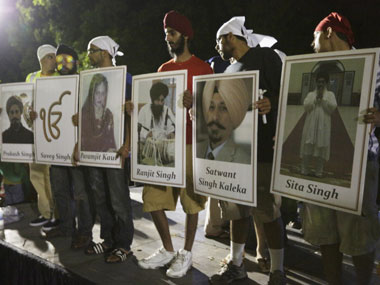A year ago the members of the Oak Creek gurdwara in Milwaukee got to together to prepare for langar . That’s when a gunman walked into the place of worship and opened fire. Six members of the gurdwara died in the barrage of bullets. Satwant Singh Kaleka. Ranjit Singh. Sita Singh. Prakash Singh. Suveg Sing Khattra. Paramjit Kaur. One year later, the Oak Creek gurdwara and its community is commemorating that terrible day with both sorrow and some hope. The hope comes from the fact that some good has been forged out of the tragedy. It led to the decision by the Federal Bureau of Investigation to track hate crimes against Sikhs as well as Hindus and Arabs. That matters because as Rajdeep Singh, director of law and policy for the Sikh Coalition says, “We can’t go to policy makers or law enforcement to make the case about crimes against our communities unless we have the official data.” [caption id=“attachment_1014093” align=“alignleft” width=“380”]  Relatives of the Wisconsin gurdwara shooting victims hold up their pictures. Reuters.[/caption] It’s allowed for residents of Oak Creek to come together and care for each other through the Sikh Healing Collective which provided trauma-focused intervention to the children. And it paved the way for some unexpected partnerships. A former white supremacist Arno Michaelis reaching out to Pardeep Kaleka whose father died in the attack. Michaelis admitted that the gurdwara attacker came from an almost identical background as his. He might even have been influenced by him. Michaelis used to sing in a white supremacist band, he had white-power tattoos and more than a dozen arrests on his rap sheet. But Kaleka accepted his overture albeit hesitantly. “We were both hoping… we could take something tragic and turn it into something positive – a learning experience for the entire community,” Kaleka told AP. They formed a community group called Serve2Unite together. They even got matching tattoos on their palms with the numbers 8-5-12 for August 5, 2012, the date of the attack. It is to the Sikh community’s enormous credit that instead of hunkering down after the devastating attack the community actually opened up. Three weeks after the shooting the gurdwara held a langar for the entire community. Ben Jealous, the President of NAACP, the premier civil rights group in the US, was impressed. “If this small Wisconsin community can open their doors and their hearts after such a breach of security, the rest of us can learn from their example,” he wrote. And the community did this without stripping themselves of the markers of their faith in an effort to blend in. In fact, the reverse happened. Kanwardeep Singh Kaleka, whose uncle died in the attack, started wearing prayer beads and a turban after the shooting. “People who died in that shooting looked different,” he told NPR. “And I found this as a valuable opportunity to show the world that no matter how different anybody looks, that we’re just as much of a human being. And in America, we’re just as American as anyone else.” Being “different” in that way does come with challenges. Kaleka said when he was about to board an airplane a young boy freaked out and looked at him in absolute terror saying “Don’t kill me, don’t kill me.” Kaleka took that as an opportunity to educate and reassure. “By the time our plane landed, like, me and that kid were high-fiving and hugging,” said Kaleka. It sounds feel-good but requires huge reservoirs of strength and the maturity to not make the easy argument viz Sikhs are not Muslims. As Vijay Prashad wrote in Counterpunch that implies that “this is violence at the wrong address.” By asserting the peace-loving nature of one group, he wrote “it assumes there are people who did do something wrong, are war-mongering and therefore deserve to be targeted.” The Sikh leadership in America chose not to go that route. Instead they chose to reach out with greater vigour. So at the anniversary this year, Robbie Parker whose daughter was killed in the Newtown elementary school massacre came to speak in Oak Creek. “He will help people like Mr. Kaleka – who lost his father in the Oak Creek shooting – understand how to move forward in the face of tragedy,” wrote Jasmeet Kaur Sidhu of South Asian Americans Leading Together or SAALT. “In this way a son will gain strength from a father and a father will be able to comfort someone else’s child." When the shooting happened last year, many had described it as an act of “senseless violence.” At that time Vijay Prashad noted that Rinku Sen, publisher of Colorlines magazine had said it was not “senseless” but “racist”. And in reaching out to different groups, the Sikh community has shown that what happened at Oak Creek does, in fact, cut across different community lines. “There are opportunities to intervene, disrupt, and build,” wrote Deepa Iyer, the former executive director of SAALT on Huffington Post. “We can start by recognizing and acknowledging the broader climate of racism and anti-immigrant sentiment that leads to hate violence in this country." It might appear to us that there is nothing in common between what happened in Oak Creek and the acquittal of George Zimmerman in Florida after he shot and killed the unarmed black youth Trayvon Martin in his housing complex. But it’s worth remembering as Iyer points out that different as those two events were, the question they posed for their communities is eerily the same. What do I tell my children? How do I protect them? That question cuts across communities. Hopefully the answer is just as interconnected.
One year after the gurdwara shootings in Oak Creek, Wisconsin, some unexpected good has been forged from the tragedy. That’s because the community chose to reach out instead of shutting down.
Advertisement
End of Article


)

)
)
)
)
)
)
)
)



